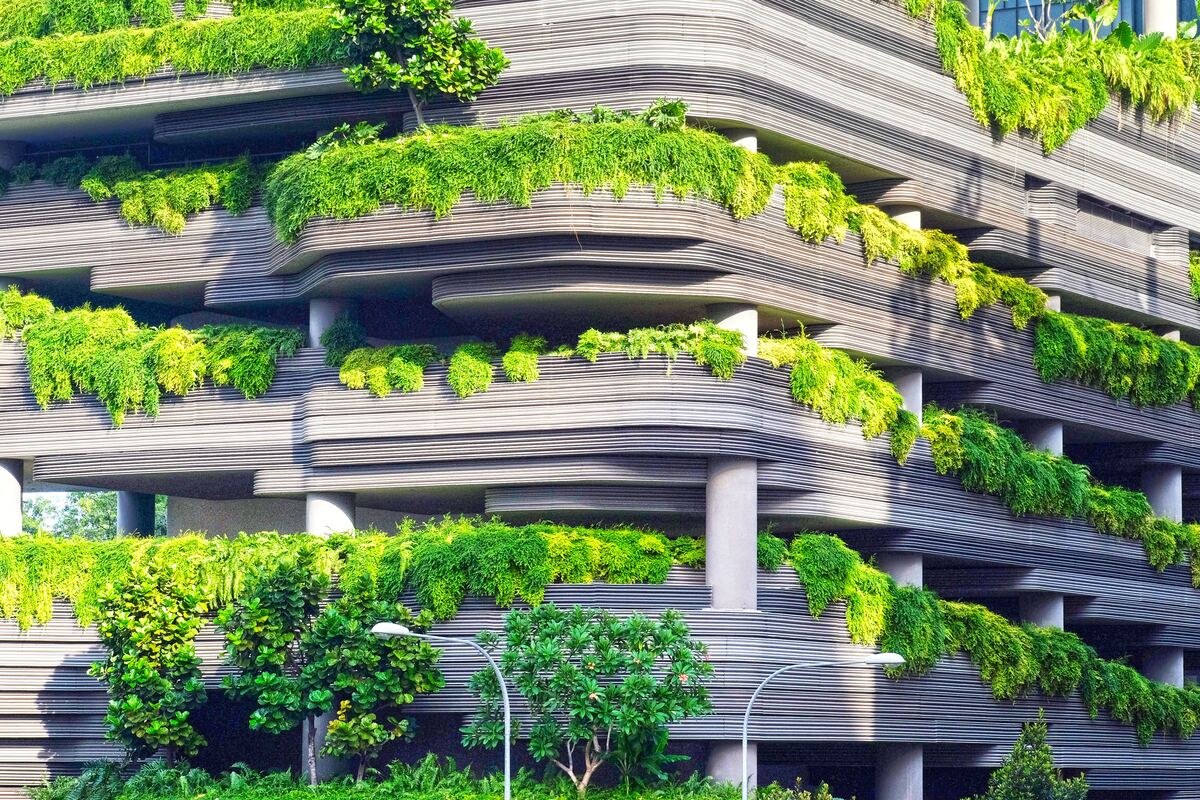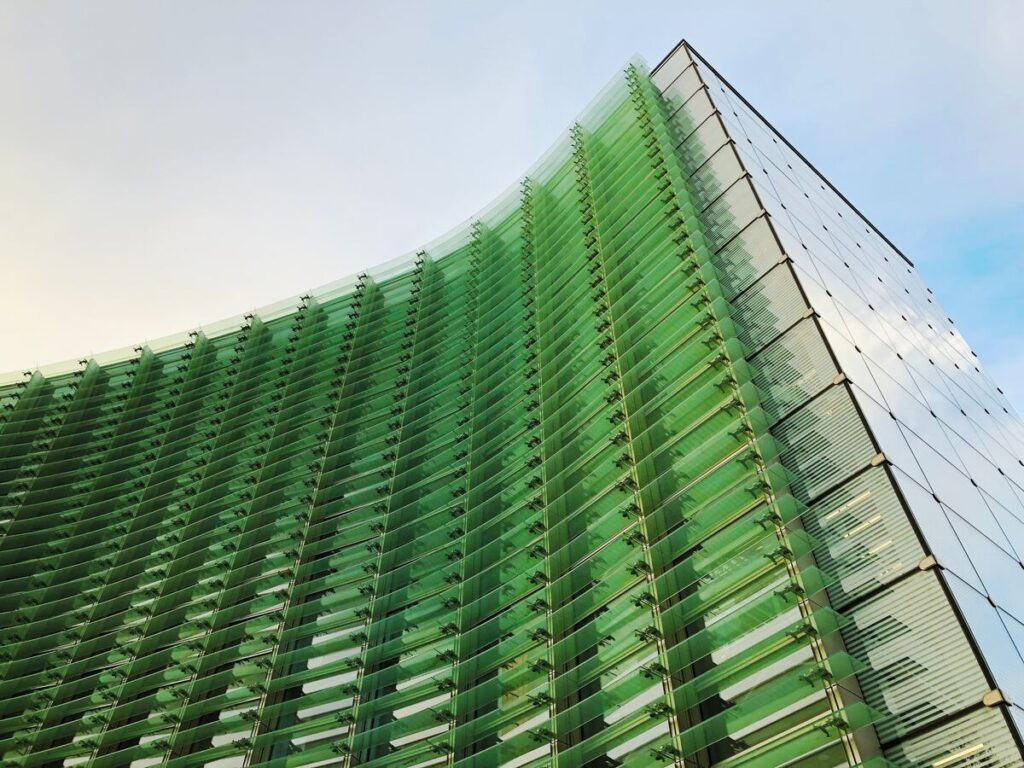Exclusive Neuroject Article: The construction sector has consistently undergone innovation throughout history. We may observe how the development of technology has affected construction materials, from the steel used in skyscrapers and bridges to the sturdy concrete utilized in historic buildings. While certain materials change over time, others are brand-new to the market. The necessity for creating new, creative solutions was brought on by the need to meet the housing demand, disasters, and rising construction costs. We’ll talk about some of the cutting-edge, new materials in this article.
Recent studies on innovation in construction materials, the persuasive estimate that the market for green building materials was worth roughly USD 192 billion in 2014 comes as a seismic discovery. It incites a fascinating discussion on the sector’s shifting goals, which indicates a fundamental shift away from conventional construction techniques and toward sustainable alternatives that promise significant economic and environmental benefits.
By 2026, the market for construction materials is expected to reach USD 1,434.3 billion, expanding at a CAGR of 8%. The prediction that the global market for materials would grow to an outstanding USD 1,434.3 billion by 2026 with an 8% CAGR paints an exciting picture of the future and acts as a beacon of possibility for the construction sector. This data appears in a blog article about new developments in construction materials, and it shows that a revolution is in the works as well as the existing demand.
Table of Contents
An Overview of Innovations in Construction Materials
Modern, high-tech construction materials are revolutionizing the construction industry. The materials of today are light, airy, and trustworthy while also being reliable, durable, and environmentally friendly. Recent years have seen a notable advancement in modern materials research. There are some truly ground-breaking new construction materials available today. Synthetic building materials are being developed that are stronger, lighter, and more environmentally friendly than conventional materials. These developments encourage the development of entirely new, ecologically friendly architecture.
A variety of cutting-edge building materials have the potential to become widely used, whereas certain contemporary construction materials may find their home in niche markets. Buildings made of conventional brick and concrete will eventually become a thing of the past because eco-friendly, energy-efficient, strong, and light buildings that look good and are highly functional are what society needs.
Our construction sector, which is mostly dominated by unbeatable technology and knowledge, is constantly innovating new building materials. We constantly delve deeper and farther into both new and old territory due to our conveniences and want to reach new heights. Innovation isn’t only about developing new technologies or construction materials; it can also be about experimenting with what we already have and enhancing it. In architecture, this could mean using waste materials creatively,
Using the fundamental building blocks in a more cultured way by sustainability principles, or using them in a more specific or expressive way. We have gathered the most intriguing and cutting-edge construction materials that are currently in use as well as some promising ideas that are being explored in pilot projects. A few building materials are not necessarily brand-new; rather, they utilize technology that has been around for a while but is still being used sparingly and in limited quantities. New building materials are employed in building structures as well as decorative treatments.
Sustainable and Eco-Friendly Materials
It is more important than ever to cut back on our energy use and make prudent construction material choices due to the inevitable rise in housing difficulties and global climate change. Eco-friendly building materials are those that can be easily recycled and don’t hurt the environment during their creation, usage, or disposal. In the long run, using eco-friendly materials is advantageous. Green home construction dramatically lowers carbon emissions and uses less energy, which leads to lower energy costs. Here we talk about some of the most recent innovations in sustainable and eco-friendly materials.
- 3D-Printed Construction Materials: Construction materials and components are being produced via additive manufacturing, also known as 3D printing. Complex designs are possible, there is less material waste, and the construction process moves more quickly. Structures can be 3D printed using concrete, plastic, and composite materials for greater efficiency and customization.
- Bio-Based Materials: In the construction sector, sustainable and renewable construction materials are becoming more popular. These products are produced using bio-based polymers, recycled resources, or agricultural waste. Bamboo, hempcrete (a material made of hemp fibers and lime), and composites based on mycelium are a few examples.
- Bioplastics: Renewable resources like corn, sugarcane, or vegetable oils are used to make bioplastics. In situations involving buildings, they can replace conventional plastics. Bioplastics may be composted or biodegraded, have smaller carbon footprints, and have less of an influence on the environment.
- Cross-Laminated Timber (CLT): Prefabricated wood panels called CLT are created by stacking layers of planks in alternating directions and joining them with adhesive. It can be utilized as a sustainable construction material substitute for steel and concrete in building construction and offers high strength and fire resistance.
- Ferrock: An environmentally beneficial substitute for conventional concrete is Ferrock. Steel dust, which serves as a binder, is one of a variety of recyclable components that go into its creation. Ferrock is a more environmentally friendly construction material for building since it has a smaller carbon footprint and can absorb carbon dioxide during curing.
- BIPV (Building-Integrated Photovoltaics): BIPV is a term used to describe the direct integration of solar cells or other photovoltaic construction materials into building components like roofs, facades, or windows. Buildings can generate electricity while also serving structural and aesthetic purposes thanks to this. BIPV systems are being adopted in sustainable construction because they are becoming more effective and aesthetically beautiful.
- Recycled and Upcycled Materials: Utilizing recycled or upcycled construction materials is becoming more popular. Reusing resources like recovered bricks, recycled plastic, or reclaimed wood can reduce waste and the environment’s impact while giving structures distinctive features.
- Air-Purifying Construction Materials: These components are made to actively remove airborne contaminants, hence enhancing indoor air quality. Examples include coatings that can absorb or neutralize contaminants and photocatalytic compounds, which use sunshine to break down toxic substances.
- Prefabricated Bamboo Panels: A sustainable and renewable construction material that can be utilized in place of conventional construction materials is bamboo. Prefabricated bamboo panels are sturdy, lightweight, and have good acoustic and thermal qualities. They can be utilized for roofing, flooring, and wall systems.
- 3D-Printed Biodegradable Materials: The use of sustainable and biodegradable construction materials for 3D printing is being investigated by researchers. These construction materials can lessen environmental impact and support the ideas of the circular economy because they are frequently made from plant-based sources or recycled materials.
- Carbon Capture and Utilization (CCU) Materials: These construction materials are designed to absorb and store carbon dioxide emissions from industrial operations so they can be used in building materials. Concrete’s carbon footprint can be decreased, for instance, by incorporating carbon capture into cement manufacture.
- Recyclable and Reusable Construction Materials: Utilizing recyclable and reusable construction materials is receiving more attention. This comprises products made of materials that are simple to disassemble, reuse, or recycle when their useful life is through. This encourages a circular economy and cuts down on waste.
- Recycled Plastic Lumber: Post-consumer plastic trash, including bottles and bags, is used to make recycled plastic timber. It can be used in place of wood in a variety of construction applications since it is durable, resistant to rot, and pest- and disease-resistant, which lowers the need for traditional lumber.
- Sound-Reducing Construction Materials: To enhance building acoustics, novel sound-reducing construction materials are being developed. These materials can block, diffuse, or absorb sound waves, which reduces noise transmission and improves indoor comfort.
- Permeable Paving Systems: By allowing water to permeate through the surface, permeable pavement technologies reduce stormwater runoff and encourage groundwater recharge. Construction materials like porous asphalt, interlocking porous pavers, or permeable concrete can be used to create these systems.

- Solar Shingles: Photovoltaic panels called solar shingles or solar roof tiles are made to look like common roofing construction materials. These tiles can produce electricity from sunlight while blending in perfectly with a building’s overall design.
- 3D-Printed Metal Structures: The 3D printing of metal structures has been made possible by developments in additive manufacturing. With the use of this technology, metal construction components can now have complicated shapes, less material waste, and greater design flexibility.
- Bioclimatic Construction Materials: The performance of a structure in response to climatic conditions is optimized using bioclimatic construction materials. These materials can control humidity, ventilation, and temperature, which lessens the need for mechanical heating, cooling, and ventilation systems.
- Recycled Rubber Products: Recycled tires are used to create recycled rubber goods like rubberized asphalt, rubber mulch, and rubberized tiles. They divert debris from landfills and provide advantages including sturdiness, impact resistance, and sustainability.
- Timber-Concrete Composite Systems: Timber-concrete composite systems, which use timber beams or panels combined with concrete slabs or connectors, combine the benefits of wood and concrete. In building, these solutions provide improved structural performance, fire resistance, and aesthetic appeal.
- Bioplastics: Bioplastics are made from renewable resources like microorganisms and plants. They can replace conventional polymers in construction materials, lowering the need for fossil fuels and the environmental impact.
- Bioluminescent Materials: Bioluminescent construction materials can produce light as a result of spontaneous biological processes. They can be utilized to create distinctive and environmentally friendly lighting solutions for both ornamental and practical lighting needs.
- Recycled Aggregates: Bricks, concrete, or other construction waste are crushed to create recycled aggregates. They can be used in place of conventional aggregates to produce concrete, saving natural resources and keeping waste out of landfills.
- Bio-Based Concrete: Concrete made from bio-based resources, such as bamboo fibers, rice husk ash, or agricultural waste, is known as bio-based concrete. Reduced carbon emissions, better thermal efficiency, and increased sustainability are all benefits of this kind of concrete.
- Photovoltaic Glass: Solar glass, commonly referred to as photovoltaic glass, has solar cells built into the glass surface. It is appropriate for windows, facades, and skylights because it enables structures to produce electricity from solar energy while keeping transparency.
- Biodegradable Composites: Composites that degrade naturally over time are produced from organic or bio-based components. They can be applied in situations or temporary buildings where minimizing environmental effects is important.
- Recycled Steel: By reusing waste steel and remelting it, recycled steel is created. It provides comparable strength and performance to virgin steel with less of an environmental effect because it doesn’t use as many raw materials or as much energy during the steel production process.
- Carbon-Negative Construction Materials: By actively extracting and storing carbon dioxide from the atmosphere during their production or lifetime, carbon-negative construction materials go beyond carbon neutrality. By lowering carbon emissions, these materials aid in the fight against climate change.
- Transparent Solar Panels: A type of photovoltaic technology called transparent solar panels produces power while permitting light to pass through. They allow buildings to produce renewable energy without sacrificing aesthetics because they may be integrated into windows or building facades.
- Recycled Plastic Lumber: Recycled plastic trash, such as used packaging or recycled bottles, is used to create recycled plastic timber. It offers durability and lowers plastic waste when used in place of conventional wood in things like decking, fences, and outdoor furniture.
- Recyclable Concrete: Recyclable Concrete is made to make it easier to separate and reclaim each of its parts for later use. This construction material encourages the concepts of the circular economy and lessens resource depletion by making recycling simpler.
- Light-Transmitting Concrete: Optical fibers that are placed within this substance, also known as translucent concrete or LiTraCon, allow light to pass through. It can be utilized to create aesthetically pleasing designs while maintaining structural integrity for architectural features like walls or panels.

Smart Materials and Adaptive Structures
Smart buildings also referred to as the ‘buildings of the future’ are hailed to be the future of the modern world and are designed with sophisticated, intelligent technology to make human lives more convenient and easier. The smart revolution has been acknowledged with open arms and has given its consumers some highly tangible advantages.
Smart materials offer a wide range of uses in technology, industry, science, and medicine, but their most common and wide-scale usage remains in civil engineering because of their ability to adjust to their properties. Here we talk about some of the most recent innovations in smart materials and adaptive structures.
- Smart Materials: Smart construction materials can react to environmental factors like temperature, humidity, and electrical signals. These substances are malleable and can alter their shape, color, transparency, and other qualities. They are used in energy-efficient windows, structural systems that can adapt to changing climatic conditions, and facades that can.
- Shape Memory Alloys (SMA): When a certain stimulus, such as a temperature change, is applied, SMA construction materials can “remember” and take on their previous shape. They can be utilized for things like self-deploying structures or adaptable building elements if the material needs to change shape or give a proactive response.
- Phase-Change Materials (PCM): During phase transitions like solid-liquid or liquid-gas transitions, PCM construction materials can store and release heat energy. They can be used to store thermal energy, which aids in controlling indoor temperature. Products with PCM enhancement, such as wallboards and insulation, can use less energy and provide a more comfortable interior environment.
- Magnetic Concrete: Magnetic construction materials are incorporated into the concrete mixture to create magnetic concrete. Since the magnetic qualities allow for exact positioning and connecting of components without the need for conventional fasteners or adhesives, it permits the design of structures that can be readily disassembled or adjusted.
- 4D Printing: Building on the idea of 3D printing, 4D printing entails making things that can alter over time in response to environmental factors. Construction may be able to use this cutting-edge technology to build self-assembling or adaptable structures.
- Electrochromic Glass: Smart glass and switchable glass are other names for electrochromic glass, which may alter its transparency or color in response to an electrical voltage. It can be applied to windows, skylights, or partition walls to control solar heat gain, privacy, and glare.
- Shape-Shifting Materials: Construction materials with shape-shifting capabilities can alter their shape or physical characteristics in response to environmental conditions including temperature, humidity, or magnetic fields. They can be utilized in projects like active facades, moveable parts, and adaptable constructions.
- Electroactive Polymers: In response to an electric field, electroactive polymers can alter structure or demonstrate mechanical movement. Applications for these construction materials include adaptive building components, energy harvesting systems, and smart windows that vary opacity.
- Magnetic Levitation Systems: Building components can be suspended and propelled using magnetic levitation systems, often known as maglev systems. This technology can be used to build structures that are both lightweight and earthquake-resistant, which eliminates the need for conventional supports.
- Electromagnetic Shielding Construction Materials: Electromagnetic shielding construction materials are significant because electromagnetic radiation from many sources is increasing. Protecting sensitive equipment or people from electromagnetic interference, these construction materials can block or limit the penetration of electromagnetic radiation.
- Shape Memory Foam: Shape memory foam is a kind of construction material that, when deformed, may regain its previous shape. It can be used for things like cushioning, seismic protection, and adaptable building elements.
- Light-Emitting Concrete: Optical fibers or light-emitting diodes (LEDs) are used in light-emitting concrete, often referred to as translucent concrete or light-transmitting concrete, to allow light to pass through. It can be applied in inventive lighting applications, decorative features, and signs.
- Programmable Cement: Programmable cement has additives that can be stimulated externally to modify its characteristics, such as stiffness or setting time. Greater control and adaptability in construction operations are made possible by this construction material.
- Magnetic Concrete: By including magnetic particles in the mixture, magnetic concrete can be drawn to or moved by magnetic fields. This construction material can be used for flexible facades, dynamic structural components, and modular buildings.
- 4D Printing Materials: Using 4D printing, it is possible to make objects that, in reaction to outside influences, can change over time in terms of shape or behavior. Dynamic and self-assembling structures can be produced using cutting-edge 4D printing materials like shape-memory polymers.
- Shape Memory Alloys: After deformation, shape memory alloys can regain their original shape. They can be employed in construction applications like mobile structures or seismic dampers when shape-changing or adaptable behavior is sought.
- Smart Glass: Switchable glass, commonly referred to as smart glass, can alter its transparency or light transmission characteristics in reaction to environmental factors like heat or electrical power. Benefits include improved energy efficiency, glare reduction, and privacy management.
- Shape-Shifting Construction Materials: Construction materials with shape-shifting capabilities can alter their form, shape, or characteristics in response to environmental factors like humidity or temperature. They can be used in deployable constructions, adaptive architecture, or morphing architectural elements.

Energy-Efficient and Insulation Materials
The walls, windows, insulation between the walls, sealants applied to the walls, air and vapor barriers built into the walls, roofing material, and other components make up a building’s envelope. Product specifiers should search for envelope parts that promote occupant comfort, guarantee clean air and keep moisture out, avoid hazardous materials, minimize heating and cooling loads, and achieve all of this while using resources effectively and producing little embodied material impact. Here are some of the recent innovations in energy-efficient and insulation materials.
- Aerogel Insulation: The substance aerogel is lightweight and has a very low heat conductivity. Due to its capacity to trap air and limit heat transfer, it is very useful in insulation applications. Walls, windows, and other places that must be energy efficient can employ aerogel insulation.
- Thermal Insulation Systems: In comparison to conventional materials, advanced thermal insulation technologies, such as vacuum insulation panels (VIPs) and aerogel-based insulation, provide better insulating performance. They can aid in lowering energy use and enhancing a building’s energy efficiency.
- Acoustic Construction Materials: Improvements in sound insulation, absorption, and control in buildings are the main goals of acoustic material innovations. To make indoor spaces quieter and more comfortable while lowering noise pollution, new construction materials and composites are being created.
- Lightweight Aggregate Concrete: When making lightweight aggregate concrete, expanded clay, shale, or pumice are used in place of the typical coarse aggregates. It is suitable for applications where weight reduction is crucial since it has decreased weight, improved thermal insulation, and increased fire resistance.
- Prefabricated Insulated Wall Systems: Precast wall panels with integrated insulation make up these systems. High thermal performance, accelerated installation, and increased energy efficiency are all offered. Buildings for homes and businesses frequently use prefabricated insulated wall systems.
- Hemp-Based Construction Materials: Construction products including hempcrete (a mixture of hemp fibers and lime), hemp insulation, and hemp-based boards can be made from hemp fibers. These construction materials have good thermal and acoustic insulation qualities and are renewable and biodegradable.
- Algae-Based Construction Materials: Algae-based construction materials are being investigated for use in buildings. Algae can be used in concrete as a bio-based binder or additive, offering a more environmentally friendly option to conventional binders. Algae can also be grown and refined to make bio-based insulating construction materials.
- Self-Cooling Construction Materials: Self-cooling construction materials are made to reflect or disperse heat, eliminating the need for power-hungry cooling equipment. These materials can increase comfort in hot regions, increase energy efficiency, and assist in managing indoor temperatures.
- Graphene Aerogel: An extremely light and highly porous construction material made from graphene is called graphene aerogel. Outstanding thermal and electrical conductivity is displayed by it. Applications for graphene aerogels include sensing, filtration, energy storage, and insulation.
- Water-Repellent Materials: Building surfaces can be coated with hydrophobic coatings or other water-repellent compounds to stop water from penetrating them. These construction materials enhance construction durability, offer protection against water damage, and require less upkeep.
- Self-Heating Materials: Construction Materials with self-heating properties can produce and hold heat. To provide energy-efficient heating solutions and lessen dependency on conventional heating systems, they can be used in construction elements such as floors or walls.
- Bio-Based Insulation: Materials for insulation with a bio-based composition are created using renewable resources like cellulose, hemp, or sheep’s wool. These construction materials can help create healthier interior environments while providing good thermal performance and moisture control.
- Phase Change Materials (PCMs): During phase transitions, such as solid-liquid or liquid-gas transitions, PCMs are substances that can absorb or release heat energy. They can be used to store thermal energy, which helps control indoor temperatures and lower energy use.
- Lightweight Concrete Foams: The addition of air or gas bubbles to the concrete mixture results in the creation of lightweight concrete foams. These foams provide better sound absorption capabilities, weight reduction, and improved thermal insulation.
- Aerogels: High porosity, low density, and superior thermal insulation characteristics are all characteristics of aerogels. They can be utilized in building envelopes as insulation materials, which will increase energy efficiency and lower heating and cooling costs.
- Thermal Barrier Coatings: Surfaces are coated with thermal barrier coatings to lessen heat transmission and increase energy efficiency. They can be used to improve thermal insulation and lower heat gain or loss on walls, roofs, or other building components.
- Acoustic Metamaterials: Engineering materials created specifically to control and modify sound waves are known as acoustic metamaterials. They can be utilized in construction projects to lower noise pollution, create sound barriers, and enhance room acoustics.
- Mycelium-Based Materials: Traditional construction materials can be replaced with mycelium-based materials, which are produced from the roots of fungi. They can be used as insulation, packaging, or even structural components because of their lightweight, insulating, and biodegradable qualities.

Self-Healing and Self-Cleaning Materials
Self-healing materials have several uses, such as protective coatings for steel and other materials exposed to corrosive conditions as well as important infrastructure including buildings, bridges, and dams. Products with self-healing capabilities last longer because they can repair minor structural flaws before they become noticeable or even measurable issues.
Self-cleaning surfaces have become a necessity. It is well known that attempts were made to assist individuals in going back to their employment and other busy venues without the threat of contracting the illness. This is a significant challenge because the majority of cleaning is now done by different teams of people who return to high-touch surfaces with sanitizers on occasion. Here are some of the recent innovations in self-healing and self-cleaning materials.
- Self-Healing Concrete: Bacterial and calcium lactate capsules are present in this substance. These capsules burst when cracks appear in the concrete, releasing the bacteria, which then eat the calcium lactate and generate limestone, filling the cracks and repairing the construction material’s integrity.
- High-Performance Coatings: The performance of construction materials is being improved via the development of novel coatings. Increased durability, corrosion resistance, waterproofing, self-cleaning qualities, and UV protection are a few advantages that these coatings can provide.
- Self-Cleaning and Air-Purifying Tiles: Self-cleaning tiles use photocatalytic construction materials, which, when exposed to light, can degrade organic contaminants and pollutants. Additionally, certain tiles are made to neutralize hazardous gases to actively filter the air.
- Self-Healing Coatings: The lifespan of the coated surfaces is increased by self-healing coatings, which are made to mend themselves when damaged. Small flaws or cracks can be immediately filled in by these coatings, preventing further degeneration of the underlying construction material.
- Shape Memory Polymer Composites: form memory Polymer composites are capable of changing shape in response to certain stimuli like heat or light. These construction materials could be used in adaptable constructions, intelligent facades, and self-repairing parts.
- Hydrogel-Based Construction Materials: Water-absorbent polymers with a high water retention capacity are known as hydrogels. They can function as moisture barriers, self-healing construction materials, or agents for controlling humidity and temperature, making them useful in the building industry.
- Self-Cleaning Roofing Materials: Special formulas are applied to self-cleaning roofing materials to prevent the formation of mold, algae, and other organic debris. To keep a clean appearance and lower maintenance needs, they take advantage of photocatalytic or hydrophobic qualities.
- Self-Healing Concrete: When fractures emerge, additives or microcapsules in self-healing concrete release chemicals that promote healing. These construction materials fill and seal cracks as a result of the environment’s reaction, extending the durability and longevity of concrete structures.
- Self-Cleaning Coatings: With the help of unique formulations, self-cleaning coatings keep building surfaces clean for longer periods by deflecting dirt, dust, and pollutants. These coatings can make spaces more aesthetically pleasing, require less care, and promote better indoor air quality.

High-Strength and Structural Materials
Advanced materials are driving innovation in the construction industry by offering enhanced strength, durability, and sustainability compared to traditional building materials. These materials, often developed through advanced manufacturing processes and material science, are transforming the way buildings and infrastructure are designed, constructed, and operated. Here are some key innovations in advanced materials with high strength used in construction.
- Transparent Aluminum: Aluminum oxynitride (ALON), also referred to as transparent aluminum, is a ceramic-like construction material that combines high strength with transparency. It might be used in optical instruments, protective coatings, and windows that can withstand gunfire.
- Graphene-Enhanced Materials: One atom-thick layer of carbon known as graphene offers extraordinary qualities like strength, electrical conductivity, and flexibility. It is being added to other construction materials, such as asphalt and concrete augmented with graphene, to increase their tensile strength and endurance.
- Carbon Fiber Reinforced Polymers (CFRP): Carbon fibers incorporated in a polymer matrix make up CFRP composites. They offer corrosion resistance, low weight, and great strength. In structural applications like the construction of bridges, repairing existing structures, and the aerospace sector, CFRP is used.
- Ultra-High-Performance Concrete (UHPC): A modern variation of concrete, UHPC demonstrates remarkable strength, toughness, and ductility. It has a significant amount of steel fibers, fine particles, and chemical admixtures. In difficult applications including bridge construction, precast components, and architectural features, UHPC is used.
- Ferrocement: A thin composite construction material called ferrocement is formed of cement mortar that has been fortified with layers of mesh or steel bars. It has great strength, is resistant to cracking, and can be shaped into intricate shapes. Ferrocement is utilized in the construction of boats, architectural components, and water tanks, among other things.
- Ultra-High-Performance Fiber-Reinforced Concrete (UHPFRC): UHPFRC is a form of concrete that includes fine fibers to increase strength and durability, like carbon or steel. It is employed in high-stress applications like bridges and tall structures because it has remarkable mechanical qualities that enable smaller and lighter structural parts.
- Bioconcrete: Self-healing bacteria are incorporated into the concrete mix to create bioconcrete, a form of concrete. When these bacteria are exposed to oxygen and water, they can create limestone that can be used to fill in concrete cracks. Structures made of concrete could be made more resilient and long-lasting by using concrete.
- Geopolymer Concrete: An alternative to conventional concrete made with Portland cement is geopolymer concrete. It is produced utilizing industrial byproducts with a reduced carbon footprint than cement, like fly ash or slag. When compared to traditional concrete, geopolymer concrete has similar or superior qualities, including great strength and durability.
- Carbon Nanotubes: Carbon atoms are arranged in cylindrical shapes to form carbon nanotubes. They have remarkable mechanical qualities including great strength and low weight. Carbon nanotubes can be used as construction materials to improve their durability and structural performance.
- Transparent Wood: To make wood transparent, lignin, which gives wood its distinctive opacity, must be removed while maintaining the wood’s structural integrity. When strength and transparency are required, transparent wood can be utilized for windows, facades, and other projects.
- Bamboo-Reinforced Concrete: Bamboo can provide tensile strength and lower the carbon footprint of construction when utilized as a reinforcing construction material in concrete. Concrete reinforced with bamboo is strong, lightweight, and performs well during earthquakes.
- Carbon Fiber Reinforced Polymers (CFRP): Carbon fibers incorporated in a polymer matrix make up CFRP composites. They provide a high strength-to-weight ratio, longevity, and corrosion resistance. Applications for CFRP composites include seismic retrofitting, bridge construction, and structural strengthening.
- Nanomaterials: Nanoscale-engineered materials have special characteristics and capabilities. They can be added to construction materials to improve strength, toughness, and other performance qualities.
- Alkali-Activated Materials: Alternatives to conventional cement-based materials include alkali-activated compounds. They are created by reacting alkaline solutions with substances like fly ash, blast furnace slag, or metakaolin. These construction materials have better durability and lower carbon emissions.
- Bio-Inspired Materials: Bio-inspired construction materials imitate or are inspired by biological structures or characteristics. Examples include products with surfaces that clean themselves, which were inspired by lotus leaves, or products with increased strength, which were created using spider silk.
- Textile-Reinforced Concrete: Concrete that has been reinforced with textiles, such as carbon or glass fibers, is known as textile-reinforced concrete (TRC). Comparing TRC to conventional reinforced concrete, you can see improvements in tensile strength, ductility, and crack resistance.
- Fire-Resistant Construction Materials: Fire-resistant Construction materials are made to withstand high temperatures and stop the spread of fire. These components, including fire-resistant gypsum boards or fire-resistant coatings, can increase building fire safety.
- 3D-Printed Concrete: In 3D-printed concrete, intricate concrete structures are built up layer by layer utilizing additive manufacturing techniques. Complex geometry, personalization, and quicker construction procedures are all made possible by this technology.
- 3D-Woven Fabrics: Three-dimensional textiles called 3D-woven fabrics are made by weaving together several fiber layers. These construction materials can be utilized to build lightweight panels, reinforce concrete, and provide superior mechanical qualities including strength and stiffness.
- Fiber-Reinforced Polymers (FRP): Composite construction materials called fiber-reinforced polymers are made of a polymer matrix that has been strengthened with fibers like carbon or glass. FRP construction materials are ideal for seismic retrofitting, bridge construction, and structural strengthening due to their high strength, lightweight properties, and corrosion resistance.

Conclusion
The development of new construction materials has an impact on construction methods. They offer improved energy efficiency and structural protection. Additionally, new materials meet the criteria for sustainability. The use of conventional materials will either completely disappear or change to newer, more affordable, and ecologically friendly alternatives.
For instance, it is anticipated that by 2025, the North American green building market will have grown to a size of about $277.16 billion. We can shed light on one of the most revolutionary trends in construction materials innovation by highlighting the increasing green building market estimates for North America. With estimates reaching a startling $277.16 billion by 2025, this highlights the industry’s enormous transition toward sustainability. It’s an indisputable indicator of the growing reliance on innovative and environmentally friendly materials, which is fueling amazing developments in the building industry.
Utilizing modern materials lowers construction expenses without sacrificing quality. You can stay on course and fulfill your environmental conservation responsibilities by being aware of the trends in the latest construction materials on the market. The building sector is prepared to tackle the challenge as sustainability becomes important on a worldwide scale by using cutting-edge materials. To ensure the industry’s resilience, sustainability, and long-term success going forward, it will be crucial to embrace new advancements in construction materials. For more studies, you can explore more particularly in terms of adopting sustainable materials and construction methods that comply with building regulations while reducing the environmental impact of the built environment.
Suggested article to read:
The Top 7 Green Architecture Projects
Resources:
Trimble Viewpoint | Constructsoft | Intellectsoft | Buildern | PlanRadar | ConstructionDive | BigRentz | ProEst | Viso.AI
For all the pictures: Freepik



